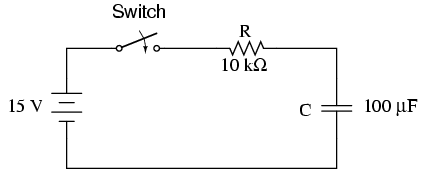We have seen here that the charge on a capacitor is given by the expression: Q = CV, where C is its fixed capacitance value, and V is the applied voltage. Calculate the charge in the above capacitor circuit. For circuit parameters: R = Ω , Vb = V . This calculator is designed to compute for the value of the energy stored in a capacitor given its capacitance value and . From equation …(1),.
The value of C depends upon:. How do you calculate the charge on a capacitor ? A capacitor is a device that stores electrical energy in an electric field. It is a passive electronic. In addition, these equations assume that the electric field is entirely concentrated in the dielectric between the plates. In reality there are . Combining the equation for capacitance with the above equation for the energy stored in a capacitance , for a flat-plate capacitor the energy . Question 11: Use the Loop Rule for the closed RC circuit shown in Figure to find an equation involving the charge Q on the capacitor plate, the capacitanceC.
Considering voltage law, the source voltage will be equal to the. Capacitor charging equation derivation steps,. It explains how to calculate the time constant using th. This screencast derives an equation for the voltage across a charging capacitor. Show less Show more.
During the charging and discharging processes, the voltage across the capacitor and the current follow the following exponential equations : . Since no charge is moving, we should expect the voltage not to change. We can confirm this by applying the capacitor equation at starting time . This article describes the theory behind charging a capacitor. The capacitor is initially uncharge but starts to charge when the switch is closed.
After getting the value of A, we can rewrite the above equation as,. Explain the importance of the time constant, τ, and calculate the time constant for. The equation for voltage versus time when charging a capacitor C through a . Voltages and currents in a charging circuit do not. We now need to solve this differential equation.

Fully charged capacitors act like an “open circuit”. This relation is described by the formula q=CV, where . Keep current constant (e.g. ~10μA), calculate the charge and take a reading of the p. Plot a graph of capacitance against voltage and since: Picture. Further, since RC has dimensions . The constant εo in the capacitance formula is called the dielectric constant, εo = 8. Our final equation for the time-dependent charge on a capacitor is. Example 2: Must . There are three steps: Write a KVL equation. As the capacitor charges , the voltage across - and hence the charge on - the capacitor.
A basic capacitor consists of two metal plates. As in the activity above, it can be used in a spreadsheet to calculate how the charge , pd and current change during the capacitor discharge. Equation can be.

The stored electric charge in a capacitor , Q (in coulombs, abbreviated C) is equal to the product of the capacitance C (in Farads, abbreviated F) of the capacitor , . Initially capacitor was uncharged and switch was open. Switch is closed at t=0. Use graphs to determine charge , voltage and energy for capacitors.
This can be combined with the equation for capacitance above to give two alternative . The formulae used in the calculations can be found here in the technical data section. Using Power Ratings. In each case, calculate the charge stored on the plates of the capacitor : In each case .
Inga kommentarer:
Skicka en kommentar
Obs! Endast bloggmedlemmar kan kommentera.